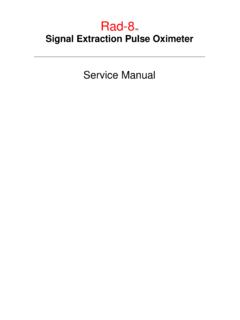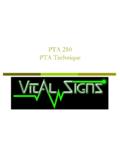Transcription of Pulse Oximetry Training Manual - who.int
1 Pulse Oximetry Training Manual 2 WHO Library Cataloguing-in-Publication Data Pulse Oximetry Training Manual . - instrumentation. - methods. , Physiologic - methods. - prevention and control. management. procedures, Operative - standards. materials. Health Organization. Patient Safety. ISBN 978 92 4 150113 2 (NLM classification: WO 178) World Health Organization 2011 All rights reserved. Publications of the World Health Organization can be obtained from WHO Press, World Health Organization, 20 Avenue Appia, 1211 Geneva 27, Switzerland (tel.: +41 22 791 3264; fax: +41 22 791 4857; e-mail: Requests for permission to reproduce or translate WHO publications whether for sale or for noncommercial distribution should be addressed to WHO Press, at the above address (fax: +41 22 791 4806; e-mail: The designations employed and the presentation of the material in this publication do not imply the expression of any opinion whatsoever on the part of the World Health Organization concerning the legal status of any country, territory, city or area or of its authorities, or concerning the delimitation of its frontiers or boundaries.))
2 Dotted lines on maps represent approximate border lines for which there may not yet be full agreement. The mention of specific companies or of certain manufacturers products does not imply that they are endorsed or recommended by the World Health Organization in preference to others of a similar nature that are not mentioned. Errors and omissions excepted, the names of proprietary products are distinguished by initial capital letters. All reasonable precautions have been taken by the World Health Organization to verify the information contained in this publication. However, the published material is being distributed without warranty of any kind, either expressed or implied. The responsibility for the interpretation and use of the material lies with the reader. In no event shall the World Health Organization be liable for damages arising from its use. 3 TABLE OF CONTENTS Page The WHO Pulse Oximetry Training Manual 4 Glossary of terms 6 Understanding the Physiology of Oxygen Transport 7 o Pulse oximeter Quiz 1 o Oxygen o Oxygen transport to the tissues o How much oxygen does the blood carry?
3 O What is Oxygen Saturation? Knowing the Pulse oximeter 9 o Pulse oximeter Quiz 2 o What does the Pulse oximeter measure? o The Pulse oximeter monitor o The Pulse oximeter probe o Practical use of the Pulse oximeter o What do the alarms tell you? o What factors can interfere with the oximeter readings? o What is not measured by the Pulse oximeter ? Understanding How Oxygen Desaturation Occurs 13 o Pulse oximeter Quiz 3 o Causes of hypoxia during anaesthesia o What should be done when the saturation falls o Management plan for Sp02 below 94% o Actions to be taken when SpO2 is 94% and below o Pulse oximeter Quiz 4 o Pulse oximeter Quiz 5 Appendix Further readings and the haemoglobin oxygen dissociation curve 22 4 THE WHO Pulse Oximetry Training Manual Welcome to the World Health Organization Pulse oximeter Training Manual .
4 WHO has recently introduced the WHO Surgical Safety Checklist as part of the Safe Surgery Saves Lives initiative. Measures to improve anaesthesia safety are integral to the programme. In many countries Pulse Oximetry is mandatory for monitoring patients during anaesthesia. Although Pulse Oximetry is a simple and reliable technology that can detect low levels of oxygen in the blood, it is only effective if the anaesthesia provider understands how an oximeter works and what to do when hypoxia is detected. This Manual describes a simple plan to respond to this situation, and explains how oximeters work and how to use them. The Manual contains essential information for all anaesthesia providers who are not experienced in using Pulse Oximetry and would be useful reading for all members of the theatre team. The content of this Manual can be studied on its own or can be taught in a classroom. Additional learning materials about Pulse Oximetry and information on the WHO Surgical Safety Checklist can be freely obtained at and at respectively.
5 The material may be freely distributed for educational purposes. 5 ACKNOWLEDGEMENTS William Berry, MD, MPH Harvard School of Public Health, Boston, USA Gonzalo Barreiro MD Sanatorio Americano, Montevideo, Uruguay Gerald Dziekan MD, MSc World Health Organization, Geneva, Switzerland Angela Enright MB, FRCPC (Editor) Royal Jubilee Hospital, Victoria, Canada Peter Evans Special Advisor Luke Funk MD, MPH Harvard School of Public Health, Boston, USA Atul Gawande MD MPH Harvard School of Public Health, Boston, USA Iain H Wilson MB ChB, FRCA Royal Devon and Exeter NHS Foundation Trust, Exeter, UK Robert J McDougall MBBS, FANZCA, GradCetHlthProfEd Royal Children's Hospital, Parkville, Victoria, Australia Alan Merry ONZM, FANZCA, FFPMANZCA, FRCA, Hon FFFLM University of Auckland, New Zealand Florian Nuevo MD, DPBA, FPBCA University of Santo Tomas, Manila, Philippines Rafael Ortega MD Boston University Medical Center, Boston, USA Michael Scott MB ChB, FRCP, FRCA Royal Surrey County Hospital, Guildford, UK Stephen Ttendo MB ChB, MMed (Anaesth) Mbarara University of Science and Technology, Mbarara, Uganda Isabeau Walker BSc MB BChir FRCA (Editor)
6 Great Ormond Street Hospital NHS Trust, London, UK David J Wilkinson MBBS, PGDip(AP), FFARCS St Bartholomew's Hospital, London, UK The editors would also like to acknowledge the assistance of Drs Regina Aleeva (Russia), Yoo Kuen Chan (Malaysia), Sarah Hodges (Uganda), Vjacheslav Istomin (Russia), Fawaz Kateb (Syria), Mikhail Kirov (Russia), Sergey Komarov (Russia), Konstantin Lebedinskiy (Russia), Jin Liu (China), Christine Manning (Canada), Isabelle Murat (France), Haydn Perndt (Australia), Dmitry Shestakov (Russia), Alexey Smetkin (Russia), Olaitan Soyannwo (Nigeria), Marina Venchikova (Russia), Lize Xiong (China) and Buwei Yu (China). 6 GLOSSARY OF TERMS Anaphylaxis A severe life threatening allergic reaction to a drug or other substance such as latex in surgical gloves Arrhythmia An abnormal heart rhythm Atelectasis Partial or total collapse of a lung or segment of a lung which has been previously expanded Bradycardia A heart rate that is too slow for the patient.
7 Adults less than 60 beats / min; children according to age see page 9 of this Manual Capnograph A monitor that detects the amount of carbon dioxide in each breath Cyanosis Dusky blue appearance of the skin, tongue or mucous membranes due to a low level of oxygenated haemoglobin in blood vessels near the skin surface Desaturated haemoglobin Haemoglobin without attached oxygen Hypotension Low blood pressure Hypothermia Low body temperature (less than 36 C) Hypoventilation Breathing at a rate and/or depth that is less than required Hypovolaemia Reduced blood volume Hypoxia Abnormally low levels of oxygen in the body Microprocessor A mini-computer that can calculate readings of Pulse rate and peripheral haemoglobin saturation from signals detected by the probe Oesophageal intubation A tracheal tube that is incorrectly inserted into the oesophagus oximeter / Oximetry Pulse oximeter / Pulse Oximetry A device that can detect a pulsatile signal in an extremity such as the finger or toe and can calculate the amount of oxygenated haemoglobin and the Pulse rate Pneumothorax Lung collapse caused by air leaking from the lung, usually following trauma.
8 Air enters the space outside the lung (pleural space) and stops the lung from expanding (also see Tension pneumothorax) Pyrexia Raised body temperature (greater than 37 C) Tension pneumothorax In a tension pneumothorax, the pressure in the pleural space is very high, the patient has severe breathing difficulties and distortion of the heart may cause cardiac arrest Vasopressors Drugs such as adrenaline, ephedrine or phenylephrine that raise the blood pressure by causing constriction of blood vessels or increased cardiac output 7 UNDERSTANDING THE PHYSIOLOGY OF OXYGEN TRANSPORT Pulse oximeter QUIZ 1 Before reading the Manual , we would like you to assess your knowledge about Pulse Oximetry . The correct answers are in the next section. 1. How is oxygen transported from the atmosphere to the tissues? 2. What is the normal oxygen saturation in arterial blood? 3. What is preoxygenation?
9 4. A patient undergoing general anaesthesia for hernia repair has an oxygen saturation of 82% during surgery. Is this reading high or low? Is any action required? _____ OXYGEN Human beings depend on oxygen for life. All organs require oxygen for metabolism but the brain and heart are particularly sensitive to a lack of oxygen. Shortage of oxygen in the body is called hypoxia. A serious shortage of oxygen for a few minutes is fatal. During anaesthesia, patients airways may become obstructed, their breathing may become depressed, their circulation may be affected by blood loss or an abnormal heart rhythm or the anaesthetic equipment may develop a problem such as an accidental disconnection or obstruction of the breathing circuit. These factors can result in a reduction of oxygen delivery to the tissues which, if not managed correctly, could lead to injury or death. The earlier the anaesthesia provider detects a problem, the sooner it can be treated so that no harm comes to the patient.
10 OXYGEN TRANSPORT TO THE TISSUES Oxygen is carried around the body attached to an iron-containing protein called haemoglobin, (Hb) contained in red blood cells. After oxygen is breathed into the lungs, it combines with the haemoglobin in red blood cells as they pass through the pulmonary capillaries. The heart pumps blood continuously around the body to deliver oxygen to the tissues. There are five important things that must happen in order to deliver enough oxygen to the tissues: Oxygen must be breathed in (or inspired) from the air or anaesthesia circuit into the lungs. Oxygen must pass from the air spaces in the lung (called the alveoli) to the blood. This is called alveolar gas exchange. The blood must contain enough haemoglobin to carry sufficient oxygen to the tissues. The heart must be able to pump enough blood to the tissues to meet the patient s oxygen requirements.
















